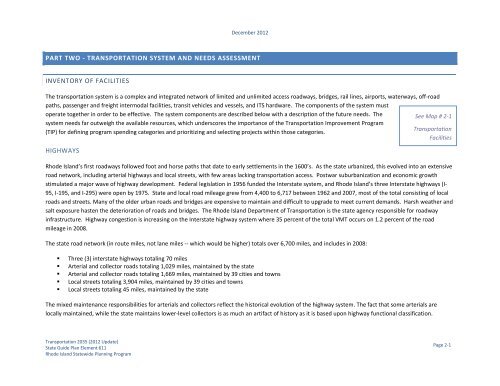Transportation 2035 - State of Rhode Island: Division of Planning
Transportation 2035 - State of Rhode Island: Division of Planning
Transportation 2035 - State of Rhode Island: Division of Planning
Create successful ePaper yourself
Turn your PDF publications into a flip-book with our unique Google optimized e-Paper software.
December 2012PART TWO - TRANSPORTATION SYSTEM AND NEEDS ASSESSMENTINVENTORY OF FACILITIESThe transportation system is a complex and integrated network <strong>of</strong> limited and unlimited access roadways, bridges, rail lines, airports, waterways, <strong>of</strong>f-roadpaths, passenger and freight intermodal facilities, transit vehicles and vessels, and ITS hardware. The components <strong>of</strong> the system mustoperate together in order to be effective. The system components are described below with a description <strong>of</strong> the future needs. Thesystem needs far outweigh the available resources, which underscores the importance <strong>of</strong> the <strong>Transportation</strong> Improvement Program(TIP) for defining program spending categories and prioritizing and selecting projects within those categories.HIGHWAYSSee Map # 2-1<strong>Transportation</strong>Facilities<strong>Rhode</strong> <strong>Island</strong>’s first roadways followed foot and horse paths that date to early settlements in the 1600’s. As the state urbanized, this evolved into an extensiveroad network, including arterial highways and local streets, with few areas lacking transportation access. Postwar suburbanization and economic growthstimulated a major wave <strong>of</strong> highway development. Federal legislation in 1956 funded the Interstate system, and <strong>Rhode</strong> <strong>Island</strong>’s three Interstate highways (I-95, I-195, and I-295) were open by 1975. <strong>State</strong> and local road mileage grew from 4,400 to 6,717 between 1962 and 2007, most <strong>of</strong> the total consisting <strong>of</strong> localroads and streets. Many <strong>of</strong> the older urban roads and bridges are expensive to maintain and difficult to upgrade to meet current demands. Harsh weather andsalt exposure hasten the deterioration <strong>of</strong> roads and bridges. The <strong>Rhode</strong> <strong>Island</strong> Department <strong>of</strong> <strong>Transportation</strong> is the state agency responsible for roadwayinfrastructure. Highway congestion is increasing on the Interstate highway system where 35 percent <strong>of</strong> the total VMT occurs on 1.2 percent <strong>of</strong> the roadmileage in 2008.The state road network (in route miles, not lane miles -- which would be higher) totals over 6,700 miles, and includes in 2008:• Three (3) interstate highways totaling 70 miles• Arterial and collector roads totaling 1,029 miles, maintained by the state• Arterial and collector roads totaling 1,669 miles, maintained by 39 cities and towns• Local streets totaling 3,904 miles, maintained by 39 cities and towns• Local streets totaling 45 miles, maintained by the stateThe mixed maintenance responsibilities for arterials and collectors reflect the historical evolution <strong>of</strong> the highway system. The fact that some arterials arelocally maintained, while the state maintains lower-level collectors is as much an artifact <strong>of</strong> history as it is based upon highway functional classification.<strong>Transportation</strong> <strong>2035</strong> (2012 Update)<strong>State</strong> Guide Plan Element 611<strong>Rhode</strong> <strong>Island</strong> <strong>State</strong>wide <strong>Planning</strong> ProgramPage 2-1
















